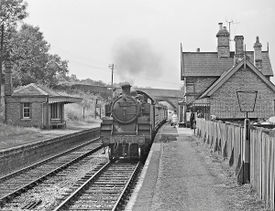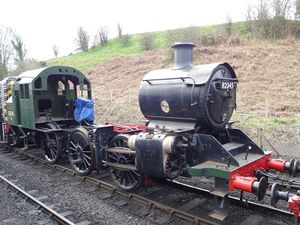BR 3MT 82045
| BR 3MT 82045 | |
|---|---|
 A member of 82045's class, BR 3MT 82009, on the SVR in 1959 | |
| Built By | 82045 Steam Locomotive Trust, Bridgnorth |
| Configuration | 2-6-2T |
| Power class | 3MT |
| Status | Under construction |
| Loco Number | 82045 |
| History | |
| Built | Under construction |
| Designed By | Robert Riddles |
| Type | BR Standard 3MT Tank |
| 1998 | 82045 project began |
| Technical | |
| Length | 40ft 10½" |
| Weight | 74t 1cwt |
| Tractive effort | 21,490 lb |
| Pressure | 200 lb/sq in |
The 82045 Steam Locomotive Trust is building a new locomotive of the Riddles BR 3MT 2‑6‑2T class, none of which survived into preservation. A number of members of this class of tank engines hauled services on the SVR during the BR era.
Contents
The 82xxx class
Most of the ‘BR Standards’ were essentially a development of the similar LMS type. However while the 3MT 2‑6‑2T chassis design was closely based on the LMS Ivatt Class 4, the boiler design was derived from the GWR No. 2 boiler as fitted to the GWR Large Prairie 2-6-2T.[1]
45 of these locomotives, numbered 82000-82044, were built at BR’s Swindon works between 1952 and 1955. All 45 began service in lined black livery, but many of those that worked on the BR Western Region were later repainted in lined green or latterly in unlined green livery.[2]
A further 18 of the class were to have been built, but the order for these was cancelled as part of BR’s Modernisation Plan. The closure of branch lines such as the Severn Valley and the replacement of steam by DMU services ultimately led to the withdrawal from service of those already built. None survived into preservation.
New build locomotive 82045
Progress
Progress on construction at March 2019 can be seen in the picture (right). The Trust issues news updates on its website with progress reports. After over a decade of working in the open, 82045 was moved into the Works on 23 January 2019.
The SVR want 82045 in service as soon as possible, and the Trust decided to put more work out to contract. In July 2022 it reached an in-principle agreement with SVR Engineering (ESMP) to contract some work to the Railway, using ESMP’s resources to add to the Trust’s volunteering efforts.[3]
The boiler and firebox are being assembled at boiler shop.[4] Earlier, the project was one of those that suffered in 2011 from the theft of copper sheets that had been cut to size for the firebox.
On 17 April 2018, 82045 became a rolling chassis when the locomotive was wheeled at Bridgnorth.
On 23 October 2021 the SVR released a video on its YouTube channel, 'Resurrecting a lost class with 82045' in which the Trust hoped for a completion date of 'later in 2023'.
On 6 December 2021 it became a 2-6-2 for the first time, when fitted with its front and rear pony trucks[5].
The Trust has also sourced some common components with the Bluebell Railway Standard Class 2 Project which is building BR Class 2MT 2-6-2 Tank Locomotive No 84030.
In 2011 the project was the beneficiary of SVRA's 'Cylinders for 82045' raffle. Including donations the gross income was over £21.000 with a net surplus of around £17,000.[6] In 2016 it was the Guarantee Company's "Slidebars and Crossheads" raffle which, in combination with an appeal to shareholders and further boosted by cash donations, generated over £30,000 for 82045.[7]
In November 2022 it was the locomotive centrepiece at the National Model Railway show at the NEC organised by the Warley Model Railway Club[8].
Livery
The Trust’s website notes that "As 82045 was destined for the WR had it been built as planned in 1956, it was decided that the loco when finished should appear in the attractive Swindon-inspired livery of dark green, lined out in orange and black. A subsequent repaint into lined black hasn't been ruled out, though."
Model
In 2018 the Trust produced a limited number of models of 82045. By May 2019 only two models remained on display at Bridgnorth Station Shop.
Gallery
See also
References
- ↑ Wikipedia
- ↑ 82045 Steam Locomotive Trust web site
- ↑ Taylor, Neil, 'Chairman’s Chat – Number 1 - July 2022', 82045 SLT website, July 2022 (Retrieved 15 August 2022)
- ↑ 82045 News, April 2018 (Retrieved 26 April 2018)
- ↑ Branch Lines, December 2021
- ↑ SVR Forum (Retrieved 23 March 2019)
- ↑ News Update - September 2016, The 82045 SLT website (Retrieved 23 March 2019)
- ↑ Branch Lines, December 2022
Links
- The 82045 Steam Locomotive Trust web site
- BR Standard Class 3 2-6-2T on Wikipedia
- The Bluebell Railway Standard Class 2 Project
- 'Resurrecting a lost class with 82045' on SVR's YouTube channel
| ||||||||||||||||||||||||||||||||||||||||||||||||||||||||




